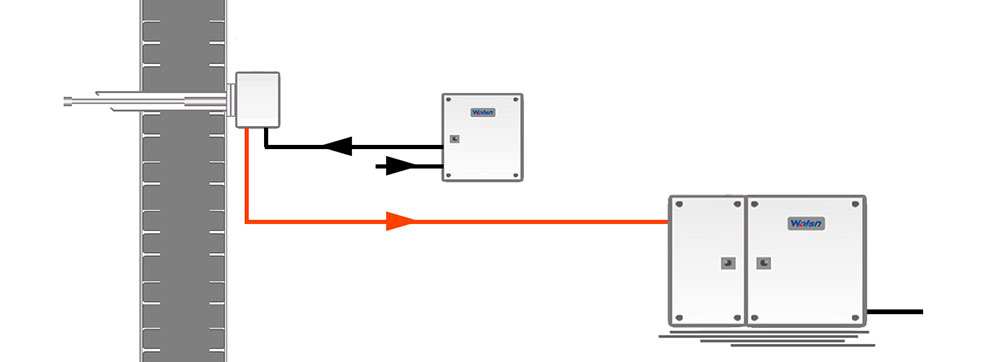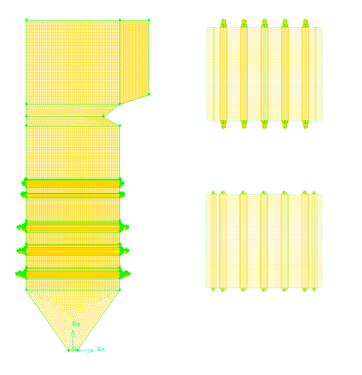 EN /
CN
EN /
CN
search the product
Search for what you are looking for here:
- Popular:EMF-SX-SOxygen AnalyzerUniMass-S
 EN /
CN
EN /
CN
Search for what you are looking for here:
For boiler combustion, controlling the CO level of flue gas can reduce incomplete combustion and the heat loss to the exhaust gas. This is due to the fact that the CO level of flue gas reflect the burning condition inside the furnace. When the furnace burning condition is not optimal, there will be coking, high temperature corrosion, or flue gas temperature deviation, resulting in boiler safety problems. It has therefore become important and necessary to detect and control CO level in the flue.
Overview
For boiler combustion, controlling the CO value of the flue gas can reduce the loss of chemical incomplete combustion and the heat loss of exhaust gas. Also, the high CO value of the flue also reflects the burning condition of the furnace, when the furnace burning is not good, there will be coking, high temperature corrosion, smoke temperature deviation, resulting in boiler safety problems. It is necessary to detect and control CO in the flue.
Walsn and Huazhong University of Science and Technology Coal Burning National Lab jointly developed the flue CO value-based boiler combustion optimization control system (SCCS-COF). Based on Walsh’s patented CO continuous detection system, CO real-time monitoring device is installed in the flue using grid point method. With CO value as key parameter, we utilize large data processing, CFD numerical calculation, thermal calculation of variable operating conditions and other technologies, to establish correlation models, such as CO-boiler efficiency model,CO-furnace outlet NOx model and CO-boiler integrated operating costs model. The models calculate and predict best wind/coal control strategy for real-time operation to achieve intelligent optimization control of boiler combustion.
SCCS-COF system can effectively improve the boiler efficiency by about 0.3% on average and save about 1 gram of coal consumption under the premise of that emission requirements are met. The system has been applied in Zhanjiang power plant, Haimen power plant, Tiling power plant and other large-scale power plants, and achieved good results.
Implementation steps
1. Build CO online real-time monitoring system
At both sides of the rear flue outlet or SCR inlet, choose 6 or 8 point, using grip point method to install a set of CEA-100 model CO real-time monitoring device at each point.

2. Modeling and CFD calculation to build CO concentration field distribution

Based on the CO value of flue, CFD calculation software is used to establish combustion, heat transfer and flow model, and finally traces the temperature field, velocity field and CO/O₂ concentration distribution field of the flue gas, which provides an effective and reliable key basis for the combustion optimization.
| Model | Model selection |
| Turbulence model | Realizable k-ε |
| Radiation model | P-1 Model |
| Coal powder particle motion model | Stochastic Particle Trajectory |
| Gas phase combustion model | Probability density distribution function |
| Coal powder combustion model | Dual parallel reaction model (volatile) Diffusion-power control combustion model (coke coal) |
3. Boiler combustion test
Through the on-site testing, the influence of factors on heat loss, such as carbon content of fly ash, CO, boiler efficiency and NOx emission is analyzed, and the result based on this data is also regarded as one of the main basis for combustion optimization modeling.
(1) Tests under the normal mode of operation
(2) Tests under the mode with variable operating oxygen, variable load and variable coal type
(3) Test under the mode with variable wind (change the proportion of auxiliary wind and burndown wind by adjusting the opening degree of the exhaust wind door bezel while maintaining the total air volume unchanged)
(4) Test under the operation mode of shifting coal mill
4. Burning data collection
(1) Collecting historical data on boiler operation (in principle, about 1 year);
(2) Collect the structure design drawings, thermal calculation instructions and specifications of the boiler;
(3) Collecting data on typical coal types in boiler history (in principle, about 1 year);
(4) Collect reports of the cold experiments on boiler history and other information.
5. Combustion optimization model establishment, boiler combustion control strategy design and SCCS-COF system construction
Combined with the CFD calculation results and CO/O₂ concentration field, the above historical data and real-time data are processed by big data technology to establish the combustion optimization model. Then the combustion optimization platform based on the optimization model is developed, which gives combustion optimization control adjustment instruction or Closed-loop control of wind volume of the boiler.
The SCCS-COF solution includes boiler efficiency monitoring and optimization, nitrogen oxide generation monitoring and optimization, and boiler integrated combustion optimization. The main optimization objectives are the boiler efficiency rate, nitrogen oxide and comprehensive operating cost. Optimization control parameters are the total oxygen volume and the burndown wind adjustment.
Function and customer value
Product function
(1) Real-time monitoring for the boiler combustion flue CO.
(2) Guidance and recommendations for boiler combustion operation. The module contains real-time recommended values for total air volume (total oxygen) and for the burndown wind.
(3) Real-time calculation and CRT display for the indicators related to the boiler combustion’s economy, safety and environmental protection. The module contains technical and economic indicators such as boiler combustion efficiency and boiler heat losses as well as the environmental indicators such as NOx target value.
(4) Intelligent automatic control of the total air volume. The system can undisturbedly switch between the automatic operation mode and the manual mode.
SCCS-COF value
Boiler efficiency improvement
This is achieved by reasonably reducing the CO concentration, fly ash carbon content (UBC) and the oxygen levels while the requirements for the safety and NOx emissions are meet. On average, the efficiency rate of the boiler can be improved by 0.3% to 0.5% and the coal consumption can be reduced by about 1 g/kwh.
Take a 600MW unit as an example:
For a unit that has 600MW unit capacity, annual utilization hours 4500, plant electricity rate of 6% and the standard coal unit price of 600 RMB / ton, the power consumption reduced by 1g (standard coal) / kwh can bring the benefits calculated as follows:
1. The annual power supply: 600 x 103 x 4500 (1-0.06) s 25.38 x 108KWh
2. The annual coal savings: 25.38 x 108 x 1 x 10-6 x 2538 tons of standard coal
3. The full year cost savings: 2538 x 600/10000 x 152.28 million RMB
Reducing pollutants emission
The emission reduction is mainly contributed by the reduction of total emissions of pollutants (including NOx) due to reduced coal consumption, and the reduction of NOx emissions from furnace outlet due to the optimal operation.